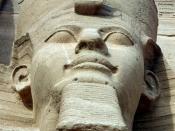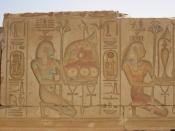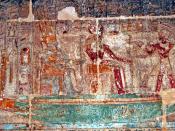These rock-cut temples are located in the ancient Wawat, or the legendary Ybsambul, in Nubia, near the borders of Sudan, about 300 kilometers from Aswan. Earlier temples in Nubia had been located within forts, but here the confidence of Ramses II, whose reign may have lasted as many as 67 years, is illustrated; these temples, probably once brightly colored, were cut into the natural rock and lapped by the Nile. After eleven centuries of oblivion, these temples were rediscovered in 1813 when Johann Ludwig Burckhardt saw by accident the upper parts of the colossal figures. In 1817 Giovanni Battista Belzoni found the entrance, partially freed from the sand. In the following years these temples were often partially covered by shifting sands. The facade of the Great Temple of Ramses is about 38 meters long and 31 meters high. The temple is dedicated to the most important gods of the New Kingdom, Ptah (the creator god of Memphis), Amun-Re (the great god of Thebes) and Re-Harakhte (sun god of Heliopolis), as well as to the Pharaoh Ramses II himself.
The four colossi, statues of Ramses II, are more than 20 meters high and about 4 meters from ear to ear. The doorway to the interior is 7 meters high. A statue of Re-Harakhte with the falcon head is in a niche over the entrance. The god is flanked by low relief depictions of Ramses II who presents him with a tiny statuette of Maat goddess of Truth and Justice. The cornice above the entrance has a frieze design of uraei (the sacred asp) and above the cornice there are twenty-two high relief statues of seated baboons with their hands raised in worshipping the sun.


